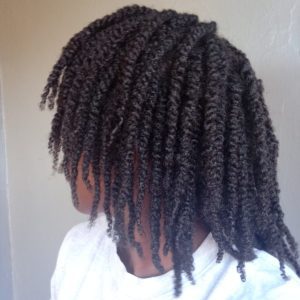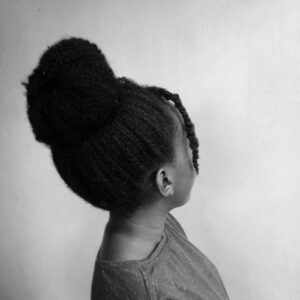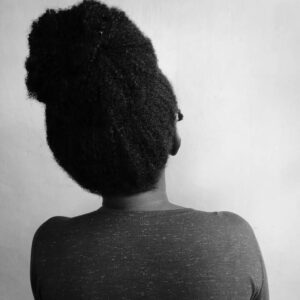Heat styling can be a game-changer when it comes to 4C natural hair. It allows you to temporarily change your texture, add versatility to your styles, and create sleek, smooth looks. However, the concern that comes with heat styling is the potential for heat damage, which can lead to breakage, split ends, and a loss of your natural curl pattern. For 4C hair, which is already more delicate and prone to dryness, these risks are even greater.
But here’s the good news: It is possible to heat style your 4C hair without damaging it! With the right techniques, tools, and products, you can enjoy the benefits of heat styling while keeping your natural hair healthy and protected. In this post, I’ll share the secrets to heat styling 4C natural hair without heat damage, along with tips to help you maintain your curls’ health and bounce.
Feel like your hair has been the same length forever, I’ve an Ebook that will help you grow your hair healthier, longer and thicker. Grab your copy here… Also, check out all the Ebooks,guides and journals that will go a long way in your hair care journey here.
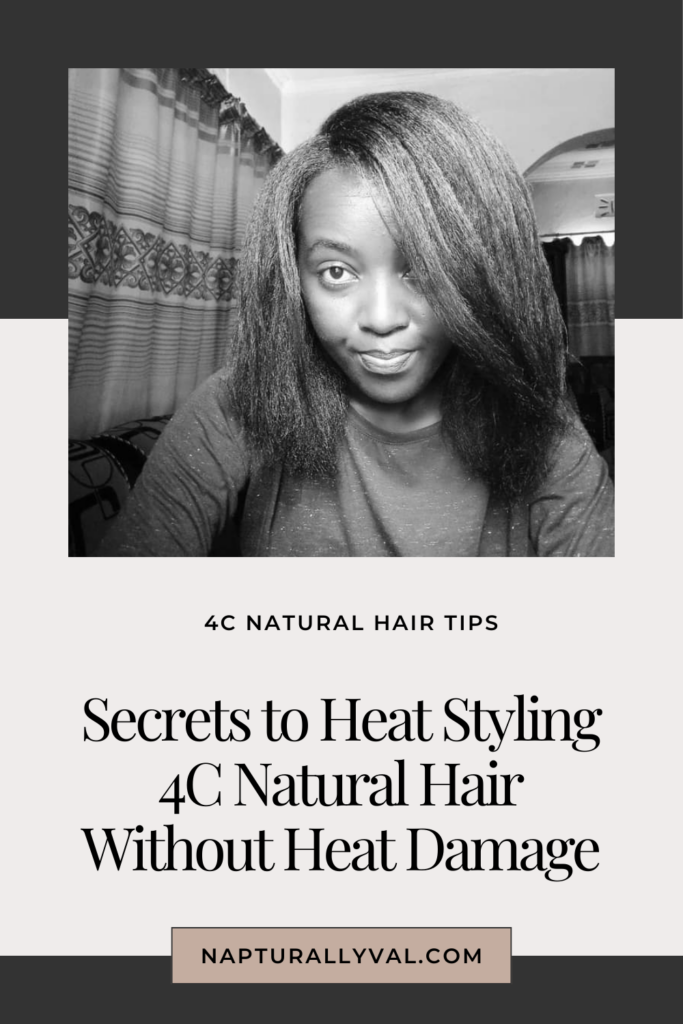
Table of Contents
Understanding 4C Hair and Heat
4C hair is the tightest curl pattern on the hair texture spectrum. It has densely packed coils, and because of its structure, it tends to be drier than other hair types. The natural oils from your scalp don’t easily travel down the shaft of 4C hair, which means your strands often lack moisture. When you introduce heat, this dryness can intensify, making your hair more vulnerable to damage.
Heat damage occurs when excessive heat breaks down the protein bonds in your hair, permanently altering its texture. Once your curls lose their elasticity or don’t revert after washing, it’s usually a sign of heat damage. This is why taking proper precautions is critical if you plan to use heat tools like flat irons, blow dryers, or curling wands.
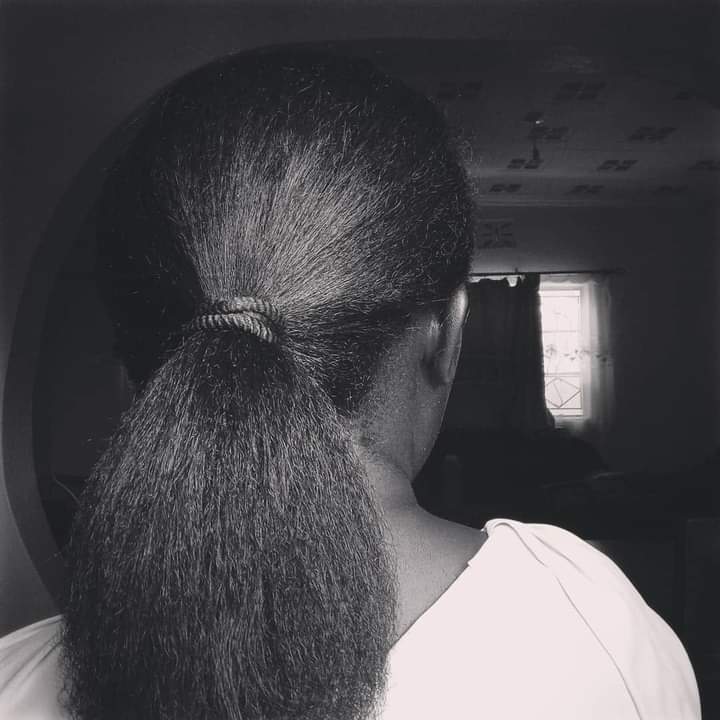
Secrets to Heat Styling 4C Natural Hair Without Heat Damage
1. Prep Your Hair with Moisture
Before you even think about grabbing that blow dryer or flat iron, it’s essential to ensure that your hair is properly moisturized. Dry hair is more likely to be damaged by heat, so the goal is to lock in as much moisture as possible.
Deep Conditioning Is Key: Always start with a good deep conditioning treatment. A moisturizing deep conditioner that contains hydrating ingredients like shea butter, aloe vera, or coconut oil is ideal. Deep condition your hair weekly, especially if you’re planning to use heat, as this will help restore moisture and strengthen your hair.
Leave-In Conditioner: After washing and deep conditioning, apply a leave-in conditioner. This will add an extra layer of moisture and help your hair retain hydration even after the heat styling process. Look for a leave-in that’s lightweight but hydrating to prevent your hair from feeling heavy or greasy.
Hydration with the LOC or LCO Method: The LOC (Liquid, Oil, Cream) or LCO (Liquid, Cream, Oil) method is a fantastic way to keep 4C hair moisturized. This technique helps seal in moisture and prevents dryness during the heat styling process. First, apply a water-based liquid or leave-in conditioner, then follow up with an oil to lock in the moisture, and finish with a cream for added protection and softness.
2. Always Use a Heat Protectant
A heat protectant is non-negotiable when it comes to heat styling. Heat protectants are designed to form a protective barrier around your hair, minimizing the effects of heat. They reduce moisture loss, prevent your hair’s protein structure from being compromised, and decrease the risk of heat damage.
Choosing the Right Heat Protectant: Opt for a heat protectant that can withstand high temperatures, ideally one that works up to 450°F (232°C). Sprays and serums are popular options, but make sure to choose one that’s formulated for natural hair and contains nourishing ingredients like argan oil, grapeseed oil, or silk proteins.
How to Apply: Make sure to apply the heat protectant evenly to your hair before blow drying, flat ironing, or using any other heat tool. Section your hair and spray or smooth the product onto each section, ensuring that every strand is covered. Do not skip this step, as it’s one of the most important factors in protecting your hair from heat damage.

3. Blow Dry with Caution
The blow dryer is often the first tool we use when heat styling natural hair. To avoid heat damage while blow drying, it’s crucial to use the right technique and settings.
Use the Tension Method: One of the best ways to blow dry 4C hair without causing damage is the tension method. This method involves stretching your hair with your hands or a brush while directing the blow dryer’s nozzle down the length of your hair. This reduces the need for excessive manipulation and helps to straighten your hair with minimal heat.
Use a Blow Dryer with a Comb Attachment: If you prefer to detangle and blow dry at the same time, a blow dryer with a comb attachment can be a great option. However, it’s important to use a wide-tooth comb attachment to minimize pulling and breakage, and always work in small sections for better control.
Cool or Medium Heat Settings: Avoid using the highest heat setting on your blow dryer. Instead, opt for a medium heat setting or, if your hair is particularly fine, a cool setting. This reduces the amount of direct heat your hair is exposed to while still allowing you to achieve a smooth blowout.
4. Flat Ironing and Curling Tips
Flat ironing or curling your 4C hair can create sleek, straight styles or defined curls, but you need to be careful not to use excessive heat. Here’s how to flat iron or curl your hair without causing damage:
Set Your Temperature: The ideal flat iron temperature for natural hair ranges from 300°F to 375°F (150°C to 190°C). If your hair is fine or low in density, stick to the lower end of this range. Never go above 400°F (204°C), as this can lead to irreversible heat damage.
Use a Ceramic or Titanium Flat Iron: Investing in a high-quality flat iron can make all the difference in how your hair reacts to heat. Ceramic flat irons are excellent because they distribute heat evenly, preventing hot spots that can burn your hair. Titanium flat irons heat up quickly and are great for thicker 4C hair, but they can be harsher on fine hair, so use them carefully.
One Pass is Enough: Avoid going over the same section of hair multiple times with your flat iron or curling wand. Doing so increases the risk of damage. Instead, work in small sections and ensure your iron is at the right temperature, so you only need one pass to achieve your desired result.
Clamp and Release: When curling, avoid clamping your hair at the same spot for too long, as this can lead to burning and breakage. Instead, use a smooth clamping and release motion to create curls without damaging your strands.
5. Limit Heat Styling Frequency
The more often you use heat on your 4C hair, the higher your risk of heat damage. While heat styling can give you a sleek look, it’s important to limit how often you use heat tools to preserve your hair’s health.
How Often Should You Heat Style?: It’s best to limit heat styling to once every 4 to 6 weeks, especially if you’re using direct heat (like flat irons or curling wands). If you love the look of heat-styled hair but want to minimize damage, consider protective styles like roller sets, flexi rods, or perm rods that give you sleek results without direct heat.
Give Your Hair Time to Recover: After heat styling, give your hair time to recover by focusing on moisture and protein treatments. This helps restore the health of your strands and keeps them strong.
6. Maintain Your Hair Post-Heat Styling
After you’ve achieved your desired look, the key to keeping your hair healthy is maintenance. Even if you’ve taken all the necessary precautions while styling, neglecting your hair afterward can lead to dryness and breakage.
Moisturize Regularly: Keep your hair moisturized after heat styling by using a lightweight moisturizer or oil. Avoid heavy products that can weigh your hair down, but don’t skip moisturizing altogether, as heat-styled hair can lose moisture more quickly than when your hair is in its natural state.

Wrap Your Hair at Night: Protect your hair while you sleep by wrapping it in a satin or silk scarf. This will help preserve your style while minimizing friction that can cause breakage or frizz. Alternatively, you can sleep on a satin pillowcase if you prefer not to wrap your hair.
Avoid Excessive Manipulation: Try not to manipulate or style your hair too much after heat styling. Constant combing or brushing can cause breakage, especially if your hair has been weakened by heat. Instead, keep your hands out of your hair as much as possible and stick to low-manipulation styles.
7. Focus on Protein Treatments
Heat styling can break down the protein bonds in your hair, so it’s important to rebuild them with protein treatments. Protein helps strengthen your hair and prevent breakage, making it an essential part of any heat-styling routine.
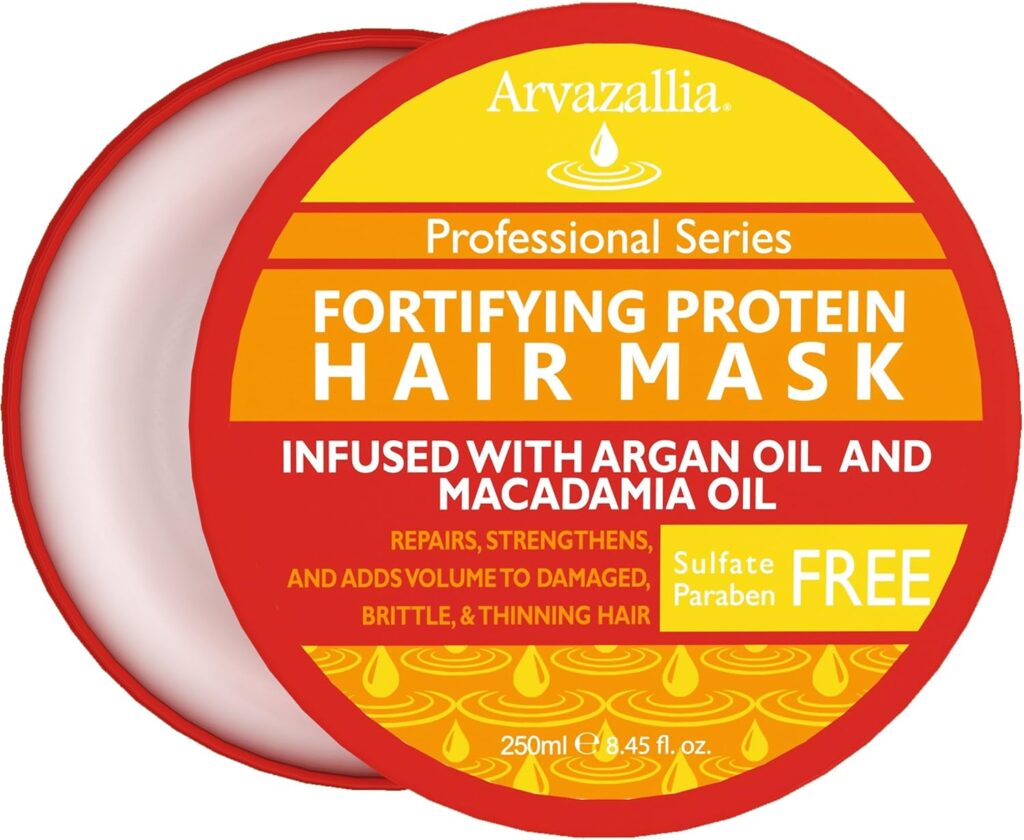
How Often Should You Do Protein Treatments?: Incorporate a protein treatment into your routine every 4 to 6 weeks, especially if you’re heat styling regularly. Look for products that contain hydrolyzed proteins, which can penetrate the hair shaft and strengthen your strands from the inside out.
Heat styling 4C natural hair doesn’t have to lead to damage if done correctly. By taking the time to properly prep your hair, use the right tools, and maintain moisture, you can enjoy sleek styles without compromising the health of your curls. Remember, it’s all about balance: Limit your use of heat, protect your hair with the right products, and always prioritize moisture and protein to keep your 4C hair strong and beautiful.

